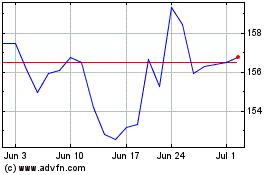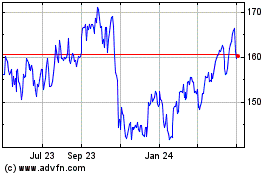By Bradley Olson
Exxon Mobil Corp., under investigation for how it values its oil
and gas wells, on Friday said it may be forced to recognize that
nearly one fifth of its reserves are no longer profitable to
produce, a sign of the toll that low prices are taking on the
giants of the energy industry.
The disclosure came as the as the largest publicly traded oil
producer reported a 38% decline in quarterly profit, the company's
eighth straight quarter of year-over-year declines. Exxon shares
were down 1% to $86.04 late Friday morning.
Some of the world's other big oil companies, including Chevron
Corp. and Statoil ASA, also reported third quarter earnings that
fell well below the same period last year, further evidence that
they face a long recovery as crude trades around $50 a barrel.
Exxon said as much as 4.6 billion barrels of its reserves may
now be unprofitable to produce, according to reserves rules set by
the U.S. Securities and Exchange Commission.
The vast majority of the holdings under scrutiny are in Canada's
oil sands, an area that has been devastated by low prices and
environmental concerns as countries around the world seek to reduce
high-emitting forms of energy -- and where Exxon is believed to be
among the lowest-cost producers. The company also said it plans to
examine its assets to test whether their value should be written
down.
The SEC and New York Attorney General Eric Schneiderman are
investigating Exxon over its accounting practices and how the value
of its future oil and gas wells could be impacted by government
action from climate change.
Rex Tillerson, Exxon's chief executive, said the company's
"operating environment remains challenging," although he and other
big oil executives recently have begun to point to signs of
improvement.
Some environmentalists cheered the news that Exxon was being
forced to re-examine the viability of oil-sands development, which
they have criticized as especially questionable in a world of
rising climate change concerns.
"For the oil sands, this is a tipping point," said Andrew Logan,
director of the oil and gas program at Ceres, a Boston-based
nonprofit that has pushed Exxon and other companies for better
disclosure on the potential impact of climate change on the energy
business.
"Why would any company invest billions of dollars in a new
oil-sands project now, given the near certainty that the world will
be transitioning away from fossil fuels during the decades it will
take for that project to pay back?" he added.
Quarterly profits disclosed this week by Exxon, Chevron, Statoil
and others were generally lower than those in the same period a
year ago. For the last 12-month stretch, they were among the lowest
for the industry in more than 15 years.
Exxon reported a 38% profit decline from the same period last
year, as revenue slid more than expected amid the prolonged swoon
in oil prices. Its third-quarter earnings fell to $2.65 billion, or
63 cents a share, from $4.24 billion, or $1.01 a share, a year
earlier.
The company was hurt by declining profits in its downstream
division, which had previously been a boon amid lower prices for
oil and gas. In the latest quarter, refining and marketing, or
downstream, earnings were $1.2 billion, down from about $2 billion
a year earlier. Exxon slashed its quarterly capital and exploration
spending by 45% from a year ago to $4.19 billion, bringing the
year-to-date decline to 39%.
Chevron, meanwhile, said its quarterly profit fell 35% from a
year earlier to $1.3 billion. Chief Executive John Watson said
third-quarter results, though down from a year ago, improved from
the first two quarters of the year.
The company has cut capital spending and operating and
administrative expenses by more than $10 billion from the first
nine months of 2015 "as a result of a series of deliberate actions
we have taken," he said.
French oil giant Total SA was a positive outlier among the major
oil companies, saying Friday that its third-quarter net profit
nearly doubled from the same period a year earlier, thanks to deep
cost cuts and rising output. Its net profit rose 81% to $1.95
billion over the period, while overall revenue contracted 8% to
$37.41 billion.
"Cost cuts have been accelerated and we will work more on it,"
said Total Chief Financial Officer Patrick de La Chevardière.
Many of the big oil companies are now close to generating enough
cash to pay for dividends and new investment. That is an inflection
point that has been closely watched by investors as a barometer for
a market turnaround.
Further spending reductions have emerged as a peculiar form of
bragging rights, with one company after another rallying after
revealing the success of cost-cutting efforts. ConocoPhillips
shares rose 5% Thursday after the company disclosed plans to cut
spending by an additional $300 million.
Oil giants are looking ahead to 2017 for signs of a modest
recovery. The Organization of the Petroleum Exporting Countries is
weighing an agreement that could continue to prop up prices. Deal
talks are picking up. Several major discoveries have added to
positive sentiment, including a recent Exxon find in Nigeria that
could hold up to a billion barrels.
"The worst is over for the sector," said Brian Youngberg, an
energy analyst with Edward Jones in St. Louis. "It doesn't mean oil
is going to go way up, but conditions are gradually improving as
markets rebalance and the companies reduce spending.
Anne Steele and Selina Williams contributed to this article
Write to Bradley Olson at Bradley.Olson@wsj.com
(END) Dow Jones Newswires
October 28, 2016 13:01 ET (17:01 GMT)
Copyright (c) 2016 Dow Jones & Company, Inc.
Chevron (NYSE:CVX)
Historical Stock Chart
From Mar 2024 to Apr 2024

Chevron (NYSE:CVX)
Historical Stock Chart
From Apr 2023 to Apr 2024
